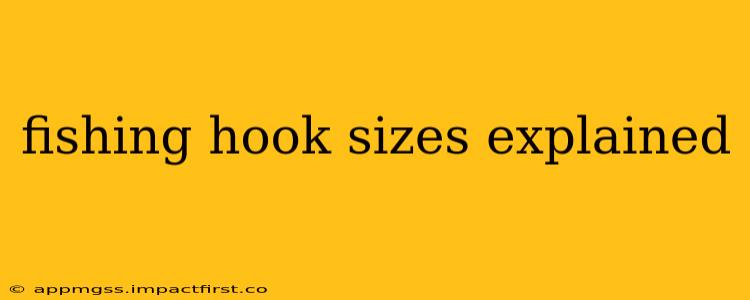Choosing the right fishing hook size is crucial for successful angling. A hook that's too large will scare fish away, while one that's too small might not securely hold your catch. This comprehensive guide breaks down fishing hook sizes, explaining the numbering system, how to choose the appropriate size, and answering frequently asked questions.
What Does the Number on a Fishing Hook Mean?
Fishing hook sizes are represented by numbers, but unlike many measurements, smaller numbers indicate larger hooks. This seemingly backward system stems from historical practices, but it's now standardized across most manufacturers. A size 1 hook is considerably larger than a size 10 hook. The exact dimensions vary slightly between manufacturers and hook styles (e.g., circle hooks, worm hooks, treble hooks), so always refer to the manufacturer's specifications for precise measurements.
How to Choose the Right Fishing Hook Size
Selecting the perfect hook size depends on several factors:
-
Target Species: Larger fish require larger hooks. A small panfish will need a smaller hook than a large bass or catfish. Research the average size of the fish you're targeting to choose an appropriately sized hook.
-
Bait or Lure Size: The hook should be proportionate to the bait or lure you're using. A tiny worm requires a small hook, whereas a large minnow or jig might need a considerably larger one. The hook shouldn't overwhelm the bait and should ideally be hidden or subtly presented.
-
Fishing Technique: Certain fishing techniques require specific hook sizes. For example, fly fishing often utilizes extremely small hooks, while trolling may require larger hooks to handle larger lures and stronger fish.
-
Hook Style: Different hook styles, such as circle hooks, J-hooks, and treble hooks, have varying sizes and gap (the distance between the hook point and shank). Circle hooks, for example, are often larger than J-hooks for the same "number" due to their design.
What is the Gap of a Fishing Hook?
The gap of a fishing hook refers to the distance between the point and the shank. A larger gap is useful when targeting larger, stronger fish, improving hook setting and reducing bending or breaking under pressure. Smaller gaps are suitable for smaller fish or delicate presentations where a smaller profile is advantageous.
What are the Different Types of Fishing Hooks?
There's a wide variety of fishing hook styles designed for specific purposes:
- J-Hooks: The most common type, ideal for a range of applications.
- Circle Hooks: Designed to hook fish in the corner of their mouth, minimizing injury and maximizing release success.
- Treble Hooks: Three hooks joined together, often used with lures to increase hook-up rates. These are often controversial due to their propensity for inflicting injury on fish.
- Worm Hooks: Specialized for holding soft plastic baits or worms securely.
- Offset Hooks: The point is slightly offset from the shank, which can be advantageous for weedless applications or to prevent snags.
What are some common hook sizes for different fish?
This is a general guideline, and individual needs may vary. Always consider the factors mentioned above.
- Panfish (Bluegill, Sunfish): Sizes 6-10
- Bass (Largemouth, Smallmouth): Sizes 1/0 - 4/0
- Trout (Rainbow, Brook): Sizes 6-8
- Catfish: Sizes 2/0 - 8/0 (depending on size)
How do I measure a fishing hook?
While hook numbers provide a general size indication, precise measurement requires using a ruler or caliper to measure the gap and hook length. Manufacturer specifications often provide detailed dimensions for each hook size.
How do I know if I'm using the right hook size?
If you're consistently losing fish or experiencing frequent hook bends or breakages, you might need to adjust your hook size. Experimenting with slightly larger or smaller hooks based on your experiences will help you fine-tune your approach.
By understanding the fishing hook size system and the factors influencing your choice, you'll greatly improve your angling success and ensure a more ethical and enjoyable fishing experience. Remember to always check manufacturer specifications for precise dimensions and consider the specific needs of your target species and fishing style.
